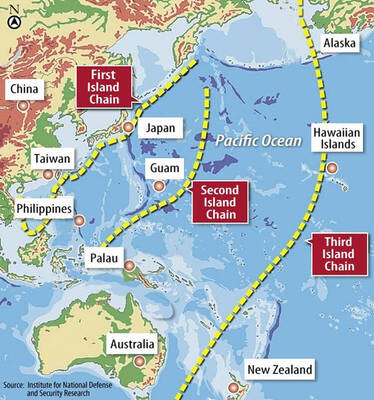China may be an economic and military giant in Asia but it still trails the US and Japan in wielding “soft power” influence in the region, a new study released yesterday said.
The US in particular remains highly regarded in all five key areas of soft power addressed in the survey: economics, culture, human capital, diplomacy and politics, said the report by The Chicago Council on Global Affairs and the East Asia Institute of South Korea.
“China’s growing economic and military might have not yet been fully translated into the elements of soft power that help a nation wield indirect influence in its region and the world,” said the report based on public opinion surveys in Japan, South Korea, Vietnam, Indonesia, China and the US.
The study said that perceptions of China’s soft power — the ability to wield influence by indirect, non-military means — “generally trail those of the United States and Japan.”
These perceptions persist despite China’s strong economic relationships in Asia and around the world, and concerted efforts by Beijing to leverage the summer Olympic Games to bolster its public image, the report said.
“The findings of this report clearly illustrate that China is recognized by its neighbors as the undisputed future leader of Asia, but it still has real work to do to win hearts and minds in the region,” said Marshall Bouton, president of The Chicago Council.
“To enhance its credibility in Asia, China will need to invest more resources in building up its soft power, especially in the diplomatic, social and cultural spheres,” he said.
The poll found that Americans, Chinese, Japanese and Indonesians all believe that China has the greatest economic influence of any nation in Asia. South Koreans and Vietnamese see it trailing only the US.
More than 6,000 interviews were conducted in January and February during the survey in the six nations. It was held before the unrest in Tibet and the Sichuan earthquake placed a spotlight on events inside China.
The report also said that contrary to other polls taken since the unpopular US invasion of Iraq in 2003, a majority of Asians in the surveyed countries still “admire” the US on many fronts, including economic, diplomatic, cultural and educational.
They see US military presence in Asia as a stabilizing force, notably preventing an arms race between China and Japan, it said.
Another “unexpected” finding showed that American feelings toward China had deteriorated since similar surveys were taken by the council in 2004 and 2006.
“A significant number of those questioned expressed general unease about the future of the relationship,” the study said.
In contrast, Chinese perceptions of the US have grown noticeably warmer compared to the 2006 survey and Chinese demonstrate consistently positive attitudes toward US influence in Asia, it said.
WARSHIP VISIT
In related news, a Japanese warship is set to arrive in China next week in the first such visit since World War II, Japanese Defense Minister Shigeru Ishiba said on Monday.
“China is an important neighbor and improving defense and other ties will be beneficial not only for us but for peace and stability in the region,” a spokeswoman quoted Ishiba as telling reporters.
The Sazanami is set to dock at a naval port in Zhanjiang, Guangdong Province, next Tuesday for a five day visit, the spokeswoman said.
During that time the crew will take part in friendship events, including a joint concert in the city, Kyodo news agency said.

The US government has signed defense cooperation agreements with Japan and the Philippines to boost the deterrence capabilities of countries in the first island chain, a report by the National Security Bureau (NSB) showed. The main countries on the first island chain include the two nations and Taiwan. The bureau is to present the report at a meeting of the legislature’s Foreign Affairs and National Defense Committee tomorrow. The US military has deployed Typhon missile systems to Japan’s Yamaguchi Prefecture and Zambales province in the Philippines during their joint military exercises. It has also installed NMESIS anti-ship systems in Japan’s Okinawa

‘WIN-WIN’: The Philippines, and central and eastern European countries are important potential drone cooperation partners, Minister of Foreign Affairs Lin Chia-lung said Minister of Foreign Affairs Lin Chia-lung (林佳龍) in an interview published yesterday confirmed that there are joint ventures between Taiwan and Poland in the drone industry. Lin made the remark in an exclusive interview with the Chinese-language Liberty Times (the Taipei Times’ sister paper). The government-backed Taiwan Excellence Drone International Business Opportunities Alliance and the Polish Chamber of Unmanned Systems on Wednesday last week signed a memorandum of understanding in Poland to develop a “non-China” supply chain for drones and work together on key technologies. Asked if Taiwan prioritized Poland among central and eastern European countries in drone collaboration, Lin

BACK TO WORK? Prosecutors said they are considering filing an appeal, while the Hsinchu City Government said it has applied for Ann Kao’s reinstatement as mayor The High Court yesterday found suspended Hsinchu mayor Ann Kao (高虹安) not guilty of embezzling assistant fees, reducing her sentence to six months in prison commutable to a fine from seven years and four months. The verdict acquitted Kao of the corruption charge, but found her guilty of causing a public official to commit document forgery. The High Prosecutors’ Office said it is reviewing the ruling and considering whether to file an appeal. The Taipei District Court in July last year sentenced Kao to seven years and four months in prison, along with a four-year deprivation of civil rights, for contravening the Anti-Corruption

NO CONFIDENCE MOTION? The premier said that being toppled by the legislature for defending the Constitution would be a democratic badge of honor for him Premier Cho Jung-tai (卓榮泰) yesterday announced that the Cabinet would not countersign the amendments to the local revenue-sharing law passed by the Legislative Yuan last month. Cho said the decision not to countersign the amendments to the Act Governing the Allocation of Government Revenues and Expenditures (財政收支劃分法) was made in accordance with the Constitution. “The decision aims to safeguard our Constitution,” he said. The Constitution stipulates the president shall, in accordance with law, promulgate laws and issue mandates with the countersignature of the head of the Executive Yuan, or with the countersignatures of both the head of the Executive Yuan and ministers or